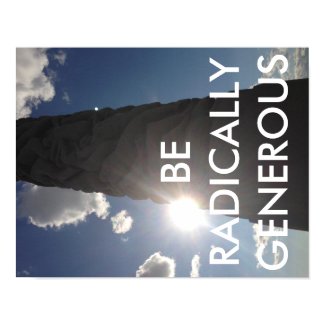You should buy it!
Click below.

Practice radical generosity! by Myriameron
Browse more Generosity Posters at Zazzle

 J.K. Rowling: A Casual Vacancy
J.K. Rowling: A Casual Vacancy
 Linda Olsson: Astrid and Veronika
Linda Olsson: Astrid and Veronika Kenji Yoshino: Covering: The Hidden assault on American Civil Rights
Kenji Yoshino: Covering: The Hidden assault on American Civil RightsReading QFinder’s post, 100 Stereotypes is more like it, I began to think a little more deeply of my own current hair dilemna. I am a law student, going into my second year. August 18th marks the beginning of the dreaded "Fall Recruitment", 8 weeks of hell during which all the second-year students compete for spots at interviews with the law firms looking for summer associates.health care, gay marriage, domestic partnerships, and millions of billions of dollars (8.14.08)
why do you hate wiw (women in wheelchairs)? (9.17.08)Beyond the debate of same-sex marriage lies the greater problem of true rights for all partnerships, and not just rights that exist, like my school’s health insurance, but rights that are realistically obtainable.
This afternoon, during rush hour, I took a bus I don’t normally take – a bus that runs rarely and is often very crowded. On this particular afternoon, as we pulled up to this particular bus stop, there were people standing on the bus, but we weren’t yet at the in-each-other’s-armpits stage yet. So we pull up to the bus stop and there is a woman in a wheel chair waiting for the bus. The driver opens the door…casual dismissal and objectification of rape in quantum of solace (11.24.08)
This weekend I went to see Quantum of Solace, and thanks to my severely reduced expectations, rather enjoyed losing myself in the car, boat and plane chases. One scene, however, snapped me from my suspended reality back to the misogynist world that Bond operates in.double shot at love; or america’s crazy love affair with bisexualism (10.11.08)
The elephant in the room, of course, is the possibility that the twins will make out on national television, which brings me to the crux of the post. America’s homophobia combines awkwardly with its misogyny to create an exception for women making out. Essentially, while LGBT people are marginalized by society, women making out (I do not use the term lesbian or bisexual here for a reason) are tolerated for the supposed turn-on factor that they provide for some straight men.the (mis)education of cathy young (3.20.09)
On Wednesday, May 18, the Washington College of Law Federalist Society hosted libertarian columnist Cathy Young to present a talk which she titled "Presumed Guilty? Rape, Feminism, and False Accusations."
Ms. Young is not a lawyer. She is a long-time columnist for The Boston Globe and Reason Magazine , libertarian publication extrodinare. Ms. Young has written extensively on both feminism and false rape accusations: here , here , here , here , HERE , here , etc. Her general premise seems to be that First Wave Feminism was a boon to women, but now that we can all get jobs and stuff, shouldn’t we look out for the menz? I realize I am oversimplifying her argument, but I will get to the substance of her speech in a moment.
Let’s return to Prometheus. I will give you three guesses what the “medically correct term” is for the removal of a fetus from a woman’s body. Abortion. It’s abortion. However Noomi’s character was impregnated, whatever the reason for her needing to remove the fetus, she needed an abortion.
 Covering: The Hidden Assault on Our Civil Rights by Kenji Yoshino
Covering: The Hidden Assault on Our Civil Rights by Kenji Yoshino Court cases between 1977 to 1982 to determine that “lawyers who litigate in the high court more frequently than their opponents will prevail substantially more often.” Kevin McGuire proposes that the more an attorney appears before the Court, the higher the likelihood of his success. Joseph Swanson takes a micro look at the certiorari process by examining three particular members of the Supreme Court bar in three particular cases, but arrives at a conclusion similar to Mr. McGuire’s: “One can only conclude that hiring experienced Supreme Court counsel to petition the Justices for review may improve one’s chances considerably.”
Court cases between 1977 to 1982 to determine that “lawyers who litigate in the high court more frequently than their opponents will prevail substantially more often.” Kevin McGuire proposes that the more an attorney appears before the Court, the higher the likelihood of his success. Joseph Swanson takes a micro look at the certiorari process by examining three particular members of the Supreme Court bar in three particular cases, but arrives at a conclusion similar to Mr. McGuire’s: “One can only conclude that hiring experienced Supreme Court counsel to petition the Justices for review may improve one’s chances considerably.”